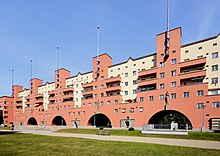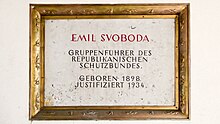Emil Swoboda
Emil Swoboda (also Svoboda ; born May 15, 1898 in Vienna ; † February 15, 1934 ibid) was an Austrian resistance fighter and member of the Republican Protection Association . He is one of the nine people who were sentenced to death and executed after the February fighting in 1934 .
Life


The locksmith's assistant lived with his wife Hermine and his children Walter (* 1923) and Amalie (* 1926) in a community building at Heiligenstädter Strasse 80 / II / 1 in the 19th district of Döbling in Vienna . This municipal building, built in 1926/27 as part of the social democratic-oriented local politics of the “ Red Vienna ” according to plans by Karl Ehn , comprised 62 apartments. Early on in social democracy, Swoboda had been a member of the Republican Protection Association for several years in 1934. He last held the rank of "group leader", which meant he commanded six men.
During the February fighting in 1934, Swoboda was one of the defenders of the Karl-Marx-Hof next to his house and led his Schutzbund group with great dedication. After his capture by the Döbling Police Department, he was brought to Regional Court II and brought before the court martial . By emergency ordinance from February 12 to 21, 1934, according to Section 73 of the StG , the crime of "riot" was also subject to court jurisdiction. Swoboda was on 15 February 1934 was legal proceedings for "riot" sentenced to death and a few hours later at the age of 36 years " Galgenhof " of the Regional Court of Vienna on Würgegalgen executed . After Karl Münichreiter and Georg Weissel , Emil Swoboda was the third Schutzbund fighter to be executed in Vienna after the February fighting. The bodies of the executed were not handed over to the relatives, but initially buried anonymously in camera.
Swoboda was finally given a grave on February 23, 1934 in the urn grove of the Simmering fire hall (Department 8, Ring 2, Group 3, Number 144). In the course of 2009, the grave sites that still existed in Department 8, Ring 2, Group 3 were abandoned by the cemetery administration and converted into a newly designed area for tree graves .
Commemoration

In February 1948, in memory of Emil Swoboda, the community building at Heiligenstädter Strasse 80 in Döbling, where he had lived with his family, was renamed “ Svoboda-Hof ”. A plaque with the inscription “ EMIL SVOBODA (sic) / GROUP LEADER OF THE / REPUBLICAN / SCHUTZBUNDES. / BORN 1898, / JUSTIFIED 1934. “reminds of him.
See also
literature
- Short biography Emil Swoboda, in: Josef Fiala: The February fights 1934 in Vienna Meidling and Liesing. A civil war that wasn't . Dissertation, University of Vienna 2012 ( online ), p. 180.
Web links
- Memorial plaque Emil Svoboda in the Vienna History Wiki of the City of Vienna
Individual evidence
- ↑ a b c d Short biography Swoboda, in: Fiala, February fights , p. 180.
- ↑ a b c d e Swobodahof. In: www.dasrotewien.at. Retrieved August 12, 2018 .
- ^ Elisabeth Winkler, Karl Münichreiter - an example of the practice of political justice in Austrofascism, in: zeitgeschichte 11/12, 1985, p. 418
- ^ Austrofascism and memory: Josef Ahrer , accessed on August 21, 2018
- ↑ Bestattung Wien - Search for the deceased: historical search for graves. In: www.friedhoefewien.at. Retrieved August 16, 2018 .
- ↑ funeral Vienna - tree graves fire hall Simmering. In: www.friedhoefewien.at. Retrieved August 16, 2018 .
| personal data | |
|---|---|
| SURNAME | Swoboda, Emil |
| ALTERNATIVE NAMES | Svoboda, Emil |
| BRIEF DESCRIPTION | Austrian resistance fighter, member of the Republican Protection Association |
| DATE OF BIRTH | May 15, 1898 |
| PLACE OF BIRTH | Vienna |
| DATE OF DEATH | February 15, 1934 |
| Place of death | Vienna |
